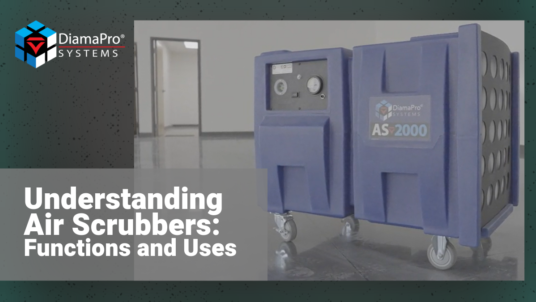
A commercial dust extractor captures and collects dust and other particulates from an area. Dust extractors all work similarly by using a fan(s) to draw air in, trapping the dust particles in one or more filters, and then expelling clean air. These are great for capturing dust particles as they are produced from the surface. But, what about the dust that is missed by the extractor and floating in the air? That’s where an air scrubber comes into play.
What is an Air Scrubber?
Dust extractors are used in conjunction with dust-generating tools to ensure that the workplace is kept as clean and safe as possible for yourself and others. They are surface cleaning tools that do little for airborne particulates.
An air scrubber is an essential piece of equipment for every job site. It is the dust extractor for the air. It draws in dirty air, filters it, and expels cleaner air. Think of it as a box fan that you might have in your home. The only difference is that it moves more air, its durable design is suitable to be used on a construction site, and it uses one or more filters to capture the fine dust.
These portable pieces of equipment are small enough to fit almost anywhere. They are quiet, allowing for use during hours of operation. They can be vented to another area expelling filtered air to another part of the building or the exterior of the building.
What Does an Air Scrubber Do?
An Air Scrubber is a vacuum for the air. They have a primary air filter, like a residential furnace. They could also have a HEPA filter that captures ultrafine airborne dust particulates that get past the main filter. They come in diverse sizes, based on CFM (cubic feet per minute) of airflow. With this unit, the amount of suction is not as important as it is with dust extractors. It is only capturing airborne particulates in the environment and not drawing from the floor where suction is needed. With an air scrubber, the amount of air that passes through them (CFM) is the most important value to look at when reviewing them.
To secure the proper sized air scrubber for your project, take the square foot of the room and multiply it by the ceiling height. This value is the volume of space in the measured area. Example: Room size = 20’ x 30’ = 600 sq.ft. with a ceiling height of 10’ = 6000 cubic feet. If you use a 2000 CFM air scrubber, the air in the room will be exchanged once every 3 minutes. DiamaPro® Systems manufactures air scrubbers in 500 CFM, 1000 CFM, and 2000 CFM. These are great to use in an area where maximum dust control is needed, which could be on every project. If you are unsure of what size air scrubber would work best in your situation, reach out to a DiamaPro® Systems Distributor for help!
Conclusion
Air scrubbers play a key role in keeping work environments clean and safe. They are commonly used in factories, workshops, and other commercial settings where airborne dust accumulation is risky. If you’re serious about the health and safety of your workplace and want to reduce health hazards, an air scrubber is a non-negotiable investment for your business.
